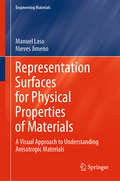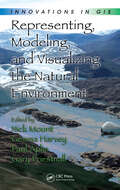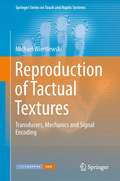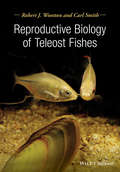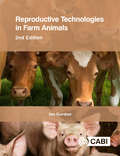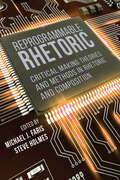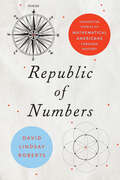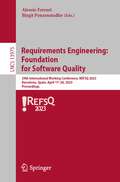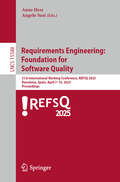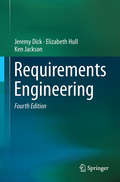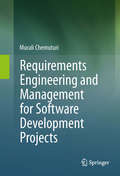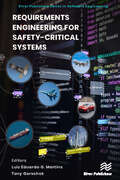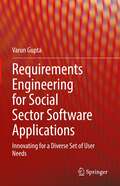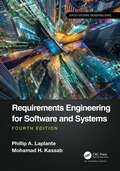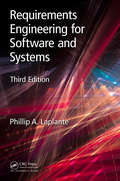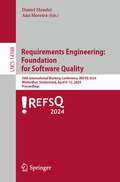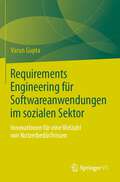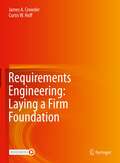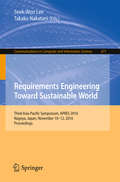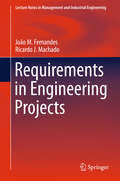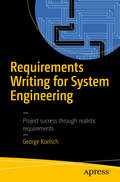- Table View
- List View
Representation Surfaces for Physical Properties of Materials: A Visual Approach to Understanding Anisotropic Materials (Engineering Materials)
by Manuel Laso Nieves JimenoThis textbook presents all the mathematical and physical concepts needed to visualize and understand representation surfaces, providing readers with a reliable and intuitive understanding of the behavior and properties of anisotropic materials, and a sound grasp of the directionality of material properties. They will learn how to extract quantitative information from representation surfaces, which encode tremendous amounts of information in a very concise way, making them especially useful in understanding higher order tensorial material properties (piezoelectric moduli, elastic compliance and rigidity, etc.) and in the design of applications based on these materials. Readers will also learn from scratch concepts on crystallography, symmetry and Cartesian tensors, which are essential for understanding anisotropic materials, their design and application. The book describes how to apply representation surfaces to a diverse range of material properties, making it a valuable resource for material scientists, mechanical engineers, and solid state physicists, as well as advanced undergraduates in Materials Science, Solid State Physics, Electronics, Optics, Mechanical Engineering, Composites and Polymer Science. Moreover, the book includes a wealth of worked-out examples, problems and exercises to help further understanding.
Representations of Nature of Science in School Science Textbooks: A Global Perspective (Teaching and Learning in Science Series)
by Christine V. McDonald Fouad Abd-El-KhalickBringing together international research on nature of science (NOS) representations in science textbooks, the unique analyses presented in this volume provides a global perspective on NOS from elementary to college level and discusses the practical implications in various regions across the globe. Contributing authors highlight the similarities and differences in NOS representations and provide recommendations for future science textbooks. This comprehensive analysis is a definitive reference work for the field of science education.
Representing, Modeling, and Visualizing the Natural Environment (Innovations in GIS)
by Nick Mount Gemma Harvey Paul Aplin Gary PriestnallThe explosion of public interest in the natural environment can, to a large extent, be attributed to greater public awareness of the impacts of global warming and climate change. This has led to increased research interest and funding directed at studies of issues affecting sensitive, natural environments. Not surprisingly, much of this work has re
Reproduction of Tactual Textures
by Michaël WiertlewskiTexture accounts for an important part of the realism of simulated experiences, and it is most certainly true during tactile interaction. We usually experience roughness by running our fingers onto the explored surface. The perception of this fine texture is mediated by the vibrations generated by the encounters of the skin and the asperities of the surfaces. Reproduction of Tactual Textures presents factors that contribute to the mechanics of the interaction between a bare finger and a surface with a view to their artificial reproduction. It discusses the recording and reproduction of tactual textures, and analyses a case study of the development of a device able to record the vibratory signal from a fingertip sliding over a textured surface. The same device is then used in a reverse way to render those previously measured signals to the user's fingertip. These developments open new questions about the biomechanical properties of the skin and their relation to perception. The second half of Reproduction of Tactual Textures focuses on the implication of the dynamic parameters of the skin onto rendering performance, and it concludes with a study on the important features that are present in the vibratory signal and their relation to texture perception. This state-of-the-art volume highlights the importance of the mechanics and biomechanics during the haptic exploration of surfaces and their possible contribution to perception. Collectively, the findings reported are pertinent to many applications, including robotic perception and the design of effective virtual reality systems.
Reproductive Biology of Angiosperms
by Arun K. PandeyThis book is designed to introduce the basics of different aspects of the biology of reproduction in a concise and coherent manner. The book aims to equip students with the fundamentals of the biology of reproduction and also update them with the most recent advances in the field of reproduction. The book has been organized into 16 chapters that introduce and explain different aspects in a stimulating manner. Each chapter is supplemented with a summary and relevant illustrations. A glossary has been added to help the students to understand some important scientific terms.The book offers comprehensive coverage of the important topics including: Flower structure and development Development and structure of male and female gametophytes Pollination biology, fertilization and self-incompatibility Endosperm, embryo and polyembryony Apomixis and seed biology A separate topic on experimental plant reproductive biology (experimental embryology) has been provided, which includes basics of cell, tissue and organ culture, anther culture, pollen culture, flower, ovary, ovule culture, embryo culture, somatic embryogenesis, synthetic seeds, protoplast culture and other aspects of plant biotechnology. The book aims to cater to the needs of the advanced undergraduate and post-graduate students in Botany, Forestry, Agriculture and related fields.
Reproductive Biology of Teleost Fishes
by Robert J. Wootton Carl SmithReproductive Biology of Teleost Fishes is the first integrated review of the reproductive biology of the bony fishes, which are the most species-rich and diversified group of vertebrates. Teleosts display remarkable variation in their modes of reproduction, and this volume is intended to provide a framework for understanding the remarkable reproductive diversity of this group. It describes their reproductive biology using, wherever possible, phylogenetic analyses and life-history theory as a means to interpret the information. The book addresses the genetic, physiological, behavioural, ecological, evolutionary and applied aspects of teleost reproduction in a comparative framework that emphasises the adaptive basis of reproductive diversity. Reproductive Biology of Teleost Fishes provides a comprehensive synthesis of fish reproduction that will be of great interest to life scientists, particularly ecologists, evolutionary biologists, physiologists and advanced undergraduates, postgraduates and research workers requiring a comprehensive overview of fish reproduction. The book is suitable for courses in fish biology and ecology, reproductive physiology and reproductive genetics. It also addresses applied questions and will be of value for courses on fisheries science and aquaculture. Libraries in all universities and research establishments where biological sciences, fisheries science and aquaculture are studied and taught should have several copies of this important book on their shelves.
Reproductive Ecology of Flowering Plants: Patterns and Processes
by Rajesh Tandon K. R. Shivanna Monika KoulSexual reproduction is the predominant mode of perpetuation for flowering plant species. Investigating the reproductive strategies of plants has grown to become a vast area of research and, in crop plants, covers events from flowering to fruit and seed development; in wild species, it extends up to seed dispersal and seedling recruitment. Thus, reproduction determines the extent of yield in crop plants and, in wild plants, also determines the efficacy of recruiting new adults to the population, making this field important both from fundamental and applied plant biology perspectives. Moreover, in light of the growing concerns regarding food and nutritional security for the growing population and preserving biological diversity, reproductive biology of flowering plants has acquired special significance. Extensive studies on various facets of reproduction are being carried out around the world. However, these studies are scattered across research journals and reviews from diverse areas of biology.The present volume covers the whole spectrum of reproductive ecology, from phenology and floral biology, to sexuality and pollination biology/ecology including floral rewards, breeding systems, apomixis and seed dispersal. In turn, transgene flow, its biosafety and mitigation approaches, and the ‘global pollinator crisis’, which has become a major international concern in light of the urgent need to sustain crop yield and biodiversity, are discussed in detail. Given its scope, the book offers a valuable resource for students, teachers and researchers of botany, zoology, ecology, agriculture and forestry, as well as conservation biologists.
Reproductive Technologies in Farm Animals
by Ian GordonBuilding on the successful structure of the first edition, the second edition of Reproductive Technologies in Farm Animals has been totally updated and revised to provide an up to date account of the key techniques employed in manipulating reproduction in farm animals, including beef and dairy cattle, pigs, sheep, goats, buffaloes, camelids, horses and poultry. A classic introductory text to the subject, the book is based on a comprehensive review of the current literature. It: - outlines different agricultural systems and explores the ethical implications of modern farming methods; - details the many new developments, including the commercial application of sexed semen and large-scale application of in vitro produced cattle embryos; - provides a valuable synopsis of current and future reproductive technologies, such as cloning and the production of transgenic animals. This text remains key reading for students in animal science, agriculture, veterinary medicine and biology, and veterinary practitioners and farmers who wish to keep updated on developments in techniques that may be useful in their daily practice.
Reprogrammable Rhetoric: Critical Making Theories and Methods in Rhetoric and Composition
by Michael J. Faris Steve HolmesReprogrammable Rhetoric offers new inroads for rhetoric and composition scholars’ past and present engagements with critical making. Moving beyond arguments of inclusion and justifications for scholarly legitimacy and past historicizations of the “material turn” in the field, this volume explores what these practices look like with both a theoretical and hands-on “how-to” approach. Chapters function not only as critical illustrations or arguments for the use of reprogrammable circuits but also as pedagogical instructions that enable readers to easily use or modify these compositions for their own ends. This collection offers nuanced theoretical perspectives on material and cultural rhetorics alongside practical tutorials for students, researchers, and teachers to explore critical making across traditional areas such as wearable sensors, Arduinos, Twitter bots, multimodal pedagogy, Raspberry Pis, and paper circuitry, as well as underexplored areas like play, gaming, text mining, bots, and electronic monuments. Designed to be taught in upper division undergraduate and graduate classrooms, these tutorials will benefit non-expert and expert critical makers alike. All contributed codes and scripts are also available on Utah State University Press’s companion website to encourage downloading, cloning, and repurposing. Contributors: Aaron Beveridge, Kendall Gerdes, Kellie Gray, Matthew Halm, Steven Hammer, Cana Uluak Itchuaqiyaq, John Jones, M.Bawar Khan, Bree McGregor, Sean Morey, Ryan Omizo, Andrew Pilsch, David Rieder, David Sheridan, Wendi Sierra, Nicholas Van Horn
Republic of Numbers: Unexpected Stories of Mathematical Americans through History
by David Lindsay RobertsThis fascinating narrative history of math in America introduces readers to the diverse and vibrant people behind pivotal moments in the nation's mathematical maturation.Once upon a time in America, few knew or cared about math. In Republic of Numbers, David Lindsay Roberts tells the story of how all that changed, as America transformed into a powerhouse of mathematical thinkers. Covering more than 200 years of American history, Roberts recounts the life stories of twenty-three Americans integral to the evolution of mathematics in this country. Beginning with self-taught Salem mathematician Nathaniel Bowditch's unexpected breakthroughs in ocean navigation and closing with the astounding work Nobel laureate John Nash did on game theory, this book is meant to be read cover to cover. Revealing the marvelous ways in which America became mathematically sophisticated, the book introduces readers to Kelly Miller, the first black man to attend Johns Hopkins, who brilliantly melded mathematics and civil rights activism; Izaak Wirszup, a Polish immigrant who survived the Holocaust and proceeded to change the face of American mathematical education; Grace Hopper, the "Machine Whisperer," who pioneered computer programming; and many other relatively unknown but vital figures. As he brings American history and culture to life, Roberts also explains key mathematical concepts, from the method of least squares, propositional logic, quaternions, and the mean-value theorem to differential equations, non-Euclidean geometry, group theory, statistical mechanics, and Fourier analysis. Republic of Numbers will appeal to anyone who is interested in learning how mathematics has intertwined with American history.
Requirements Engineering: 29th International Working Conference, REFSQ 2023, Barcelona, Spain, April 17–20, 2023, Proceedings (Lecture Notes in Computer Science #13975)
by Alessio Ferrari Birgit PenzenstadlerThis book constitutes the refereed proceedings of the 29th International Working Conference on Requirements Engineering: Foundation for Software Quality, REFSQ 2023, which took place in Barcelona, Spain, during April 17-20, 2023.The 12 full technical design and scientific evaluation papers, 8 short research previews and vision papers, and 5 experience reports presented in this volume were carefully reviewed and selected from 78 submissions. They were organized in topical sections as follows: Requirements communication and conceptualization; NLP and machine learning for AI; RE for artificial intelligence; crowd RE; and RE in practice.
Requirements Engineering: 31st International Working Conference, REFSQ 2025, Barcelona, Spain, April 7–10, 2025, Proceedings (Lecture Notes in Computer Science #15588)
by Anne Hess Angelo SusiThis book constitutes the refereed proceedings of the 31st International Working Conference on Requirements Engineering: Foundation for Software Quality, REFSQ 2025, held in Barcelona, Spain, during April 7–10, 2025. The 21 full papers and 8 short papers included in this book were carefully reviewed and selected from 74 submissions. They were organized in topical sections as follows: Responsible RE; Crowd and Large-Scale RE; Requirements Modeling; Requirements Elicitation and Analysis; Participatory RE; RE for Safety-critical and Autonomous Systems; and Requirements Quality Assurance.
Requirements Engineering: A Structured Project Information Approach (Practitioner Ser.)
by Ken Jackson Elizabeth Hull Jeremy DickWritten for those who want to develop their knowledge of requirements engineering process, whether practitioners or students. Using the latest research and driven by practical experience from industry, this book gives useful hints to practitioners on how to write and structure requirements. - Explains the importance of Systems Engineering and the creation of effective solutions to problems - Describes the underlying representations used in system modeling - data flow diagrams; statecharts; object-oriented approaches - Covers a generic multi-layer requirements process - Discusses the key elements of effective requirements management - Includes a chapter written by one of the developers of rich traceability - Introduces an overview of DOORS - a software tool which serves as an enabler of a requirements management process Additional material and links are available at: http://www. requirementsengineering. info "In recent years we have been finding ourselves with a shortage of engineers with good competence in requirements engineering. Perhaps this is in part because requirements management tool vendors have persuaded management that a glitzy tool will solve their requirements engineering problems. Of course, the tools only make it possible for engineers who understand requirements engineering to do a better job. This book goes a long way towards building a foundational set of skills in requirements engineering, so that today's powerful tools can be used sensibly. Of particular value is a recognition of the place software requirements have within the system context, and of ways for dealing with that sensitive connection. This is an important book. I think its particular value in industry will be to bring the requirements engineers and their internal customers to a practical common understanding of what can and should be achieved. " (Byron Purves, Technical Fellow, The Boeing Company)
Requirements Engineering and Management for Software Development Projects
by Murali ChemuturiRequirements Engineering and Management for Software Development Projects presents a complete guide on requirements for software development including engineering, computer science and management activities. It is the first book to cover all aspects of requirements management in software development projects. This book introduces the understanding of the requirements, elicitation and gathering, requirements analysis, verification and validation of the requirements, establishment of requirements, different methodologies in brief, requirements traceability and change management among other topics. The best practices, pitfalls, and metrics used for efficient software requirements management are also covered. Intended for the professional market, including software engineers, programmers, designers and researchers, this book is also suitable for advanced-level students in computer science or engineering courses as a textbook or reference.
Requirements Engineering for Safety-Critical Systems
by Luiz Eduardo G. Martins Tony GorschekSafety-Critical Systems (SCS) are increasingly present in people's daily activities. In the means of transport, in medical treatments, in industrial processes, in the control of air, land, maritime traffic, and many other situations, we use and depend on SCS. The requirements engineering of any system is crucial for the proper development of the same, and it becomes even more relevant for the development of SCS. Requirements Engineering is a discipline that focuses on the development of techniques, methods, processes, and tools that assist in the design of software and systems, covering the activities of elicitation, analysis, modeling and specification, validation, and management of requirements. The complete specification of system requirements establishes the basis for its architectural design. It offers a description of the functional and quality aspects that should guide the implementation and system evolution. In this book, we discuss essential elements of requirements engineering applied to SCS, such as the relationship between safety/hazard analysis and requirements specification, a balance between conservative and agile methodologies during SCS development, the role of requirements engineering in safety cases, and requirements engineering maturity model for SCS. This book provides relevant insights for professionals, students, and researchers interested in improving the quality of the SCS development process, making system requirements a solid foundation for improving the safety and security of future systems.
Requirements Engineering for Social Sector Software Applications: Innovating for a Diverse Set of User Needs
by Varun GuptaThis book presents interdisciplinary research in software engineering with applications for the social sector. The author focuses on software applications that are used for social good and that serve the needs of society. The author aims to bridge the knowledge gap between requirement engineers, industry, and users in order to help identify a diverse range of needs in the social sector (taking into account user crowd diversity in terms of technological competencies, geography, demographics, and behavioral and psychographic aspects). The book provides rigorous empirical studies and validates solutions that serve as a guide to the software engineering community, researchers, graduate students, and teachers.Provides interdisciplinary research in software engineering and the needs of the social sector, helping to increase success rates of society focused startups and applicationsIdeal for social entrepreneurs who can use the book for doing customer development with diverse usersEstablishes a new research line of social sector requirement engineering, taking into account user age, language, ability, and access
Requirements Engineering for Software and Systems (Applied Software Engineering Series)
by Phillip A. Laplante Mohamad H. KassabSolid requirements engineering has increasingly been recognized as the key to improved, on-time, and on-budget delivery of software and systems projects. New software tools are emerging that are empowering practicing engineers to improve their requirements engineering habits. However, these tools are not usually easy to use without significant training. Requirements Engineering for Software and Systems, Fourth Edition is intended to provide a comprehensive treatment of the theoretical and practical aspects of discovering, analyzing, modeling, validating, testing, and writing requirements for systems of all kinds, with an intentional focus on software-intensive systems. It brings into play a variety of formal methods, social models, and modern requirements writing techniques to be useful to practicing engineers. The book is intended for professional software engineers, systems engineers, and senior and graduate students of software or systems engineering. Since the first edition, there have been made many changes and improvements to this textbook. Feedback from instructors, students, and corporate users was used to correct, expand, and improve the materials. The fourth edition features two newly added chapters: "On Non-Functional Requirements" and "Requirements Engineering: Road Map to the Future." The latter provides a discussion on the relationship between requirements engineering and such emerging and disruptive technologies as Internet of Things, Cloud Computing, Blockchain, Artificial Intelligence, and Affective Computing. All chapters of the book were significantly expanded with new materials that keep the book relevant to current industrial practices. Readers will find expanded discussions on new elicitation techniques, agile approaches (e.g., Kanpan, SAFe, and DEVOps), requirements tools, requirements representation, risk management approaches, and functional size measurement methods. The fourth edition also has significant additions of vignettes, exercises, and references. Another new feature is scannable QR codes linked to sites containing updates, tools, videos, and discussion forums to keep readers current with the dynamic field of requirements engineering.
Requirements Engineering for Software and Systems, Third Edition (Applied Software Engineering Series)
by Phillip A. LaplanteSolid requirements engineering has increasingly been recognized as the key to improved, on-time, and on-budget delivery of software and systems projects. This textbook provides a comprehensive treatment of the theoretical and practical aspects of discovering, analyzing, modeling, validating, testing, and writing requirements for systems of all kinds, with an intentional focus on software-intensive systems. It brings into play a variety of formal methods, social models, and modern requirements for writing techniques to be useful to the practicing engineer. This book was written to support both undergraduate and graduate requirements engineering courses. Each chapter includes simple, intermediate, and advanced exercises. Advanced exercises are suitable as a research assignment or independent study and are denoted by an asterisk. Various exemplar systems illustrate points throughout the book, and four systems in particular—a baggage handling system, a point of sale system, a smart home system, and a wet well pumping system—are used repeatedly. These systems involve application domains with which most readers are likely to be familiar, and they cover a wide range of applications from embedded to organic in both industrial and consumer implementations. Vignettes at the end of each chapter provide mini-case studies showing how the learning in the chapter can be employed in real systems. Requirements engineering is a dynamic ?eld and this text keeps pace with these changes. Since the ?rst edition of this text, there have been many changes and improvements. Feedback from instructors, students, and corporate users of the text was used to correct, expand, and improve the material. This third edition includes many new topics, expanded discussions, additional exercises, and more examples. A focus on safety critical systems, where appropriate in examples and exercises, has also been introduced. Discussions have also been added to address the important domain of the Internet of Things. Another signi?cant change involved the transition from the retired IEEE Standard 830, which was referenced throughout previous editions of the text, to its successor, the ISO/IEC/IEEE 29148 standard.
Requirements Engineering: 30th International Working Conference, REFSQ 2024, Winterthur, Switzerland, April 8–11, 2024, Proceedings (Lecture Notes in Computer Science #14588)
by Daniel Mendez Ana MoreiraThis book constitutes the refereed proceedings of the 30th International Working Conference on Requirements Engineering: Foundation for Software Quality, REFSQ 2024, held in Winterthur, Switzerland, during April 8–12, 2024.The 14 full papers and 8 short papers included in this book were carefully reviewed and selected from 59 submissions. They are organized in topical sections as follows: quality models for requirements engineering; quality requirements; explainability with and in requirements engineering; artificial intelligence for requirements engineering; natural language processing for requirements engineering; requirements engineering for artificial intelligence; crowd-based requirements engineering; and emerging topics and challenges in requirements engineering.
Requirements Engineering für Softwareanwendungen im sozialen Sektor: Innovationen für eine Vielzahl von Nutzerbedürfnissen
by Varun GuptaDieses Buch stellt interdisziplinäre Forschung im Bereich Software-Engineering von Anwendungen für den sozialen Sektor vor. Der Autor konzentriert sich auf Softwareanwendungen, die für soziale Zwecke eingesetzt werden und den Bedürfnissen der Gesellschaft dienen. Der Autor möchte die Wissenslücke zwischen den Requirements Engineers, der Industrie und den Nutzern schließen, um dazu beizutragen, ein breites Spektrum an Bedürfnissen im sozialen Sektor zu identifizieren (unter Berücksichtigung der Vielfalt der Nutzergruppen in Bezug auf technologische Kompetenzen, Geografie, Demografie sowie verhaltensbezogene und psychografische Aspekte). Das Buch bietet rigorose empirische Studien und validierte Lösungen, die als Leitfaden für die Software-Engineering-Gemeinschaft sowie Forscher, Doktoranden und Lehrer dienen. - Bietet interdisziplinäre Forschung im Bereich Software-Engineering sowie den Bedürfnissen des sozialen Sektors und trägt dazu bei, die Erfolgsquote von auf die Gesellschaft ausgerichteten Startups und Anwendungen zu erhöhen- Ideal für soziale Unternehmer, um das Buch für die Kundenentwicklung mit verschiedenen Nutzern nutzen zu können - Etabliert eine neue Forschungslinie für die Entwicklung von Anforderungen im sozialen Sektor, die Alter, Sprache, Fähigkeiten und Zugang der Nutzer berücksichtigt.
Requirements Engineering: Laying a Firm Foundation
by James A. Crowder Curtis W. HoffThis textbook lays the foundations for System-of-Systems Requirements Engineering and Requirements Management practices, principles, technique, and processes. It provides a comprehensive treatment of requirements engineering, an integral part of Multidisciplinary Systems Engineering. The book takes the student/reader though the entire process of documenting, analyzing, tracing, prioritizing, and managing requirements, and then goes on the describe controlling and communicating requirement change throughout the system development lifecycle. The authors discuss the role of requirements management in support of other requirements engineering processes; describe the principal requirements engineering activities and their relationships; introduces techniques for requirements elicitation and analysis and describes requirements validation and the role of requirements reviews; and discusses the role of requirements management in support of other requirements engineering processes. A full suite of classroom material is provided including exercises, assignments, and PowerPoint slides.
Requirements Engineering Toward Sustainable World
by Seok-Won Lee Takako NakataniThis book constitutes the proceedings of the Third Asia Pacific Requirements Engineering Symposium, APRES 2016, held in Nagoya, Japan, in November 2016.The 7 full papers presented together with three short papers, were carefully reviewed and selected from 14 submissions. The papers are organized in topical sections on requirements traceability and prioritization; requirements modeling and process for quality; requirements validation; requirements analysis.
Requirements in Engineering Projects
by João M. Fernandes Ricardo J. MachadoThis book focuses on various topics related to engineering and management of requirements, in particular elicitation, negotiation, prioritisation, and documentation (whether with natural languages or with graphical models). The book provides methods and techniques that help to characterise, in a systematic manner, the requirements of the intended engineering system. It was written with the goal of being adopted as the main text for courses on requirements engineering, or as a strong reference to the topics of requirements in courses with a broader scope. It can also be used in vocational courses, for professionals interested in the software and information systems domain. Readers who have finished this book will be able to: - establish and plan a requirements engineering process within the development of complex engineering systems; - define and identify the types of relevant requirements in engineering projects; - choose and apply the most appropriate techniques to elicit the requirements of a given system; - conduct and manage negotiation and prioritisation processes for the requirements of a given engineering system; - document the requirements of the system under development, either in natural language or with graphical and formal models. Each chapter includes a set of exercises.
Requirements Writing for System Engineering
by George KoelschLearn how to create good requirements when designing hardware and software systems. While this book emphasizes writing traditional "shall" statements, it also provides guidance on use case design and creating user stories in support of agile methodologies. The book surveys modeling techniques and various tools that support requirements collection and analysis. You'll learn to manage requirements, including discussions of document types and digital approaches using spreadsheets, generic databases, and dedicated requirements tools. Good, clear examples are presented, many related to real-world work the author has done during his career. Requirements Writing for System Engineeringantages of different requirements approaches and implement them correctly as your needs evolve. Unlike most requirements books, Requirements Writing for System Engineering teaches writing both hardware and software requirements because many projects include both areas. To exemplify this approach, two example projects are developed throughout the book, one focusing on hardware and the other on software. This book Presents many techniques for capturing requirements. Demonstrates gap analysis to find missing requirements. Shows how to address both software and hardware, as most projects involve both. Provides extensive examples of "shall" statements, user stories, and use cases. Explains how to supplement or replace traditional requirement statements with user stories and use cases that work well in agile development environments What You Will Learn Understand the 14 techniques for capturing all requirements. Address software and hardware needs; because most projects involve both. Ensure all statements meet the 16 attributes of a good requirement. Differentiate the 19 different functional types of requirement, and the 31 non-functional types. Write requirements properly based on extensive examples of good 'shall' statements, user stories, and use cases. Employ modeling techniques to mitigate the imprecision of words. Audience Writing Requirements teaches you to write requirements the correct way. It is targeted at the requirements engineer who wants to improve and master his craft. This is also an excellent book from which to teach requirements engineering at the university level. Government organizations at all levels, from Federal to local levels, can use this book to ensure they begin all development projects correctly. As well, contractor companies supporting government development are also excellent audiences for this book.
The Rescue Mission (Tom Swift, #6)
by Victor AppletonTom and his friends find themselves in the hands of unfriendly robots who are trying to eliminate all biological life from their planet.
